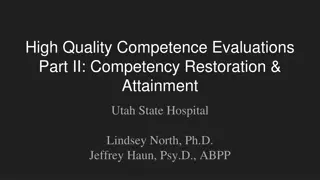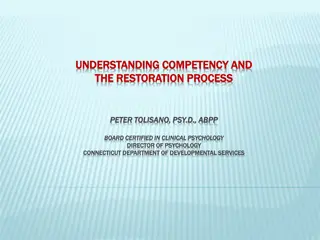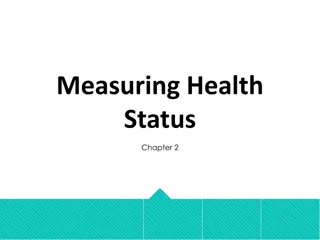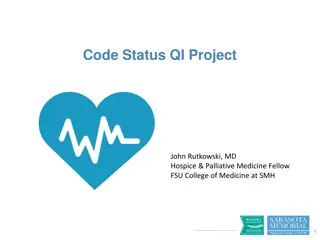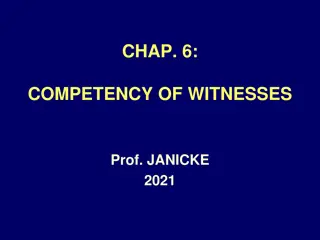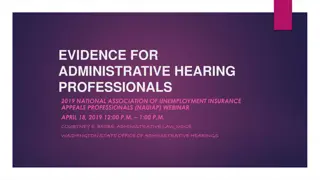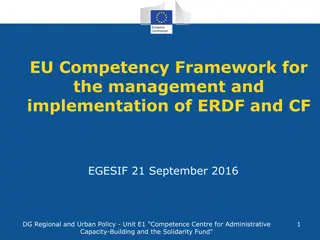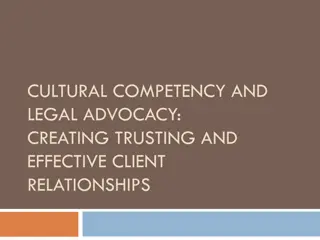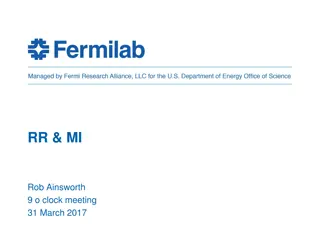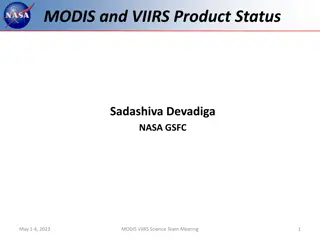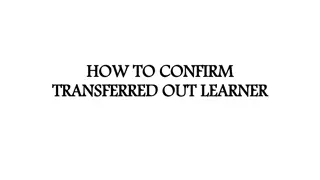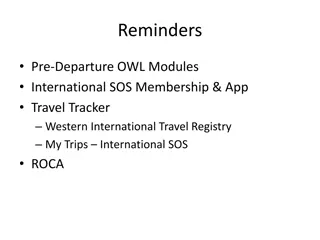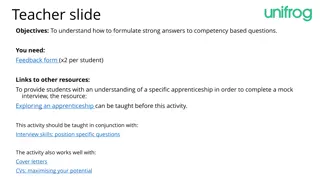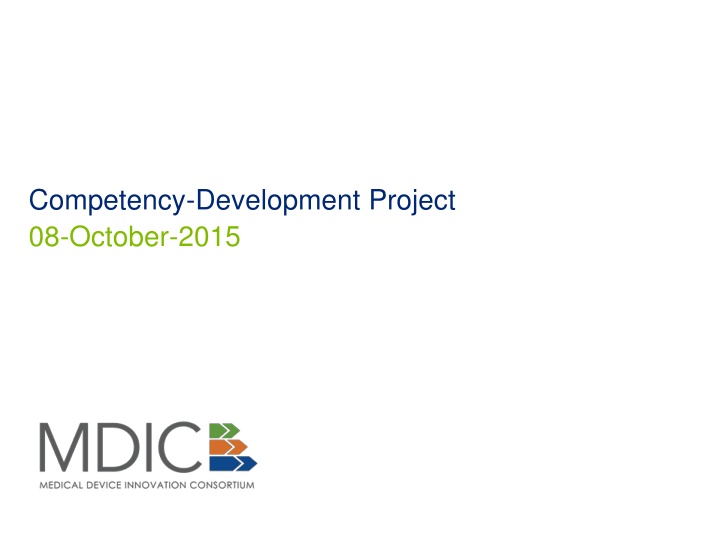
Improving Medical Device Quality Through Competency Development Project
Enhance medical device quality by fostering competency, awareness, and collaboration among key stakeholders. Explore the objectives, milestones, and competencies established to drive quality improvement in the medical device industry.
Uploaded on | 0 Views
Download Presentation

Please find below an Image/Link to download the presentation.
The content on the website is provided AS IS for your information and personal use only. It may not be sold, licensed, or shared on other websites without obtaining consent from the author. If you encounter any issues during the download, it is possible that the publisher has removed the file from their server.
You are allowed to download the files provided on this website for personal or commercial use, subject to the condition that they are used lawfully. All files are the property of their respective owners.
The content on the website is provided AS IS for your information and personal use only. It may not be sold, licensed, or shared on other websites without obtaining consent from the author.
E N D
Presentation Transcript
Competency-Development Project 08-October-2015 http://mdic.org/wp-content/uploads/2014/01/MDIC-Logo3.png
What is the Competency-Development Project? Purpose: The purpose of this project is to improve medical device Quality by improving overall competency, awareness, and understanding across key stakeholders that have the most influence on device Quality. Problem Description: Inconsistent understanding of what comprises device Quality, and a lack of clarity of other stakeholder s perspectives, needs, and constraints, is a contributing factor to inefficiencies and risks across the medical device industry. Mission Statement: Improve device Quality and patient safety by promoting programs where regulators, payers, providers, and industry professionals learn together in a collaborative environment. Move beyond cost-containment and compliance to a more holistic realization of Quality aligned with stakeholder s needs. 2 MDIC
Status Report: Competency Development 8 Oct 2015 Results / Accomplishments Key Deliverables / Milestones Completed matrix of competencies and roles Call on 3 Sept that discussed competencies with divergent ratings. Percent Complete Milestones / Deliverable Due Date Status Define list of roles & competencies C 23 Jul 15 100 % Develop expected competency/skills for each role 3 Sept 15 100 % C Perform current state assessment G 1 Oct 15 0 % Issues/Risks Actions Does the work of this group represent a broader viewpoint? Validate recommendations of this group (e.g. online survey tool) Perform gap analysis 15 Oct 15 0 % Prioritize gaps 12 Nov 15 0% Develop high-level suggestions 3 Dec 15 0% Elaborate suggestions for low- hanging fruit 17 Dec 15 0% Plan Phase 2 7 Jan 16 0 % Upcoming Activities Activity Target Date Assess current state 1 Oct 15 G Y R C = On Time = At Risk = Late = Complete 3 MDIC
Key milestones and overall project timeline July 2015 August 2015 September 2015 October 2015 November 2015 December 2015 January 2016 February 2016 March 2016 Develop Survey Define roles & competencies Conduct Survey Survey expected (ideal state) competencies Survey current state competencies Analysis & Recommendations Timeline Perform Gap Analysis Prioritize Gaps Create high-level suggestions Create detailed suggestions for low-hanging fruit. Phase 2 Plan Phase 2 4 MDIC
Competency List Established We developed 24 competencies across categories of Regulatory Awareness, Execution, Understanding Value, and Soft Skills. Regulatory Awareness Understanding of applicable regulations and how to comply. Understanding applicable laws (e.g. US Food & Drug Law, Health Canada, EU MDD, etc.) Understanding the major technologies (software, plastics, etc.), including what can go wrong, and how to apply the regulations to those technologies, and current state of practice Understanding applicable standards Understanding relevant therapies Understand appropriate implementation of Quality Systems Understanding of what a nonconformity means, what a recall means, etc Understanding significance of regulatory communication (e.g. understand some observations are worse than others; severity more important than quantity.) What makes a good management review? 5 MDIC
Roles List Established Regulators Investigator/Auditor (FDA/NB/HC/..) Perform facility inspections, consumer complaint investigations, collect physical and documentary samples. Provide training, perform first line of review of reports from Investigators (e.g. review for completeness, accuracy, appropriate evidence), review potentially violative conditions, preliminary assessment of potential 483, make first recommendation (e.g. is this OAI) and forwards to Compliance Officer if appropriate. Review Inspection Reports, exhibits, 483s, samples, etc., that were noted as potentially violatives. Review 483 information and confirms that is supportable by evidence that is collected and confirms regulatory citations. Makes preliminary assessments of other potentially violative information such as website materials, labeling, need for 510(k) submission. Determines next step in process (e.g. administrative action vs judicial action) Determines if issues need to be escalated to the Center vs. handling locally. Understanding local firms inside of the District and use this information to prioritize where resources are best spent. Establish device policy, set strategic priorities for Center, (e.g. provide excellent customer service, striking right balance between preMarket/postMarket.) Develop enforcement strategies, respond to Congressional inquiries. Receives escalations from District and takes appropriate actions. "Sets the tone for how the Center is going to do business." Receive submissions and evaluate performance. Determination of substantial equivalence (510(k)), review testing / data in the application, review clinical information, make requests for additional information to support regulatory decision. We developed 44 roles across categories of Regulator, Manufacturer, Provider, Patient, Payor, etc. Field Management (first line supervisors) Compliance Officer District Management Center Management Reviewers (510(k), PMA) 6 MDIC
Ideal-State Survey Complete There are 24 competencies and ~44 roles; this equates to a survey of 1056 pairs! 7 MDIC
Please assign a value for each competency-role pairing using numeric values Key: 3 = high importance 2 = medium importance 1 = low importance 0 = no or insignificant importance blank = no opinion Are there any major differences between scores? If so, how many times is there a difference? Investigator/Auditor (FDA/NB/HC/..) Difference ? 3 Resp 1 Resp 2 Resp 3 Resp 4 Resp 5 Resp 6 Resp 7 Resp 8 Resp 9 # Resp Sum Avg Max Min Regulatory Awareness Understanding of applicable regulations and how to comply. Understanding applicable laws (e.g. US Food & Drug Law, Health Canada, EU MDD, etc.) Understanding the major technologies (software, plastics, etc.), including what can go wrong, and how to apply the regulations to those technologies, and current state of practice Understanding applicable standards Understanding relevant therapies Understand appropriate implementation of Quality Systems C-Suite understanding of what a nonconformity means, what a recall means, etc (current phrasing is scary) Understanding significance of regulatory communication (e.g. understand some observations are worse than others; severity more important than quantity.) What makes a good management review? (focus on causes not symptoms) (look at updated 13485) N/A N/A 3 2 3 3 3 N/A 5 14 2.8 3 2 N/A N/A 3 3 2 3 3 N/A 5 14 2.8 3 2 2 N/A N/A 2 2 3 3 3 N/A 5 13 2.6 3 2 N/A N/A 3 3 2 3 3 N/A 5 14 2.8 3 2 1 N/A N/A 2 2 2 2 3 N/A 5 11 2.2 3 2 1 N/A N/A 3 2 3 3 3 N/A 5 14 2.8 3 2 N/A N/A N/A 3 3 3 3 N/A 4 12 3 3 3 N/A N/A 3 2 3 3 3 N/A 5 14 2.8 3 2 1 N/A N/A 3 2 2 3 3 N/A 5 13 2.6 3 2 8 MDIC
Interesting Discoveries As we were reviewing, we looked at places where there were significantly different ratings (e.g. one respondent rated High Importance, another rated No Importance.) Sometimes, a single viewpoint was an outlier. Other times, different interpretations or different visions of an ideal world drove the differences. Examples are: Key Opinion Leaders that role is used in 2 ways, one which requires a high-level of competency, another which does not. - Trainers do they need to be masters of their material, or are they a delivery mechanism? - HR to successfully build Quality into organizational culture, need a strong understanding of the Quality principles. - 9 MDIC
Next Steps The next steps is to perform a gap analysis and prioritization steps. Note that the survey will not be the only source used to determine gaps & priorities; this is a talented team with lots of experience, and the survey results will be supplemented with personal experience and published analyses. 10 MDIC
Questions? 11 MDIC




